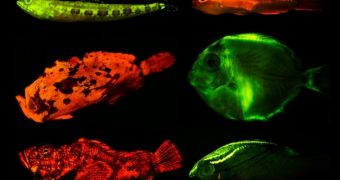Scientists from the American Museum of Natural History (AMNH), in New York City, determined in a new study that more than 180 marine species belonging to as many as 50 taxonomic families display a property called biofluorescence (biological fluorescence).
Fluorescence in this case refers to the emission of light from an organism that has absorbed electromagnetic radiations of various kinds. Usually, the light being emitted is of lower energy, or longer wavelengths, than the light that was originally absorbed.
Marine creatures including numerous species of fish use this capability for a variety of purposes, from hunting and staying safe from predators to attracting prospective mates. Most often, shades of bright orange, red and green are produced through biofluorescence in fish.
These conclusions belong to a new study published in the January 8 issue of the peer-reviewed open-access journal PLoS ONE, a magazine edited by the Public Library of Science. During a series of experiments, scientists used cameras outfitted with various types of filters to look at several species.
“It's like they have their own little private light show going on. We were surprised to find it in so many,” comments AMNH curator of ichthyology and study co-leader, John Sparks. One of the fish analyzed in the study was the flathead fish (Cociella hutchinsi), from the Pacific Ocean.
According to the team, biofluorescence can be found in many types of marine creatures, such as sharks, sting rays, flatfishes, and even eels. What is even more interesting is that some of these groups shared their last common ancestor more than 400 million years ago.
What this implies is that biofluorescence evolved separately within these groups, without being transmitted horizontally from one to the other. This capability is not limited to marine species, as it can also be observed in corals, arthropods and parrots, Nature News reports.
It is also important to note here that biofluorescence is different than bioluminescence. The latter refers to the ability that certain lifeforms have of producing light from within their bodies, via different chemical reactions. Fluorescence is based on absorbing and re-emitting light, not producing it outright.
Interestingly, the new study may also open the way towards new biomarkers. Given the abundance of biofluorescent species, it may be that some of the molecules that allow access to this capability may be used by doctors to track various types of cells in the human body.
This approach could be used to keep track on diseases such as cancer, enabling oncologists to tell early on whether or not the treatments they are using are effective on their patients.

 14 DAY TRIAL //
14 DAY TRIAL //